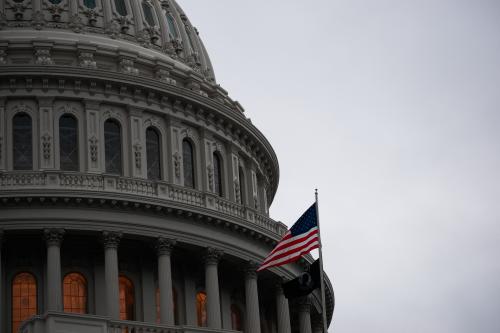On Monday the National Bureau of Economic Research made it official: the United States economy is in a recession. The pronouncement by the Bureau, the recognized arbiter of the nation’s business cycles, comes as little surprise. Economists of all stripes have been warning as much for several months, and in recent weeks the weakened condition of the economy has been apparent for all to see.
Somewhat less expected, however, is the Bureau’s conclusion that the recession began in December 2007, a full year ago. But the reasoning, based on the employment and domestic production performance since that time, is hard to refute. Debates in Congress and throughout Washington about the need for and shape of a stimulus package should reflect an appropriate sense of urgency.
This urgency is best met not only with a timely response, but also one that is well-targeted to the needs of the economy. As President-Elect Obama calls for his team to come up with an Economic Recovery Plan to remedy the impending economic slump, we urge all policy-makers to recognize that spending in areas like infrastructure maintenance and repair can both stimulate the economy and serve valuable public needs.
Although the credit crunch has been the focus of economic policy to date, the main problem for the economy going forward is likely to be the falling demand due to the broader recession, rather than the availability of credit. The slowdown in general economic activity means that consumers will be spending less. Businesses will be hurt by a reduction in the demand for their goods and services, and will invest less as profitable opportunities to expand become scarce.
In the long run, of course, American consumers will need to save more and consume less than they have in recent years. But if everyone makes this change right away, a cascade effect could deepen the recession. Firms, not knowing how much consumers are cutting back, may become fearful and cut jobs. This can erode consumer confidence even further and cause consumers to buy even less. To help smooth this business cycle fluctuation, the federal government can spend more now, taking on some additional debt that will need to be repaid later when the economy has recovered.
Congress has been debating an economic stimulus package that includes infrastructure spending and economic and energy assistance. Relief cannot come soon enough. Few economists believe that the worst is behind us. While the NBER does not forecast, economists surveyed recently by both the Wall Street Journal and the National Association for Business Economics do not expect growth to return until the second half of next year.
For these reasons, Congress should act as soon as possible. The best way to get out of these economic doldrums is to institute a broader program of fiscal stimulus that either spends public funds directly, or gets money in to the hands of those who will spend it.
Analysis ranging from the Congressional Budget Office to Mark Zandi of Moody’s Economy.com indicates that new spending will stimulate aggregate demand far more effectively than the tax changes that were so often discussed during this year’s election campaign. Additional expenditures on Food Stamps and Unemployment Insurance are well-targeted to boost spending, but these programs alone cannot absorb the $300 billion or more that should be spent to get the country’s economic heartbeat going again. This number is about 2 percent of GDP, which many economists agree is the level needed to actually make a difference.
Spending on infrastructure and on aid to states would also provide major benefits, and should be a part of the stimulus package. Accelerated repair and maintenance work could both keep workers in their jobs and fill real national needs in transportation and in our forests and parks. The key is to ensure that the stimulus package includes strong oversight to ensure spending is focused on small, short-term projects that can get started immediately.
In addition, because states cannot generally engage in deficit spending and have limited reserves, falling state tax revenues due to the weakening economy must be met with painful spending cuts. Federal aid to state governments could prevent this from happening. Because Medicaid and associated public health programs are such large parts of state budgets, much of any aid to states would in practice go to fund health care services for those who need them most.
The economist John Maynard Keynes, in famously arguing that the economy could be stimulated by even otherwise frivolous activities such as paying people to dig holes, wryly noted that it “would, indeed, be more sensible to build houses and the like“. In crafting legislation to help the economy through these troubled economic times, we should not lose sight of our broader needs and goals as a nation. While the priority for an economic recovery package must be to efficiently stimulate demand, among similarly effective targets for spending we should favor those that are also socially worthwhile. Projects that serve otherwise valuable needs – like infrastructure and public health insurance – fit that bill.

Commentary
Op-edThe Time for Fiscal Stimulus is Now
December 2, 2008